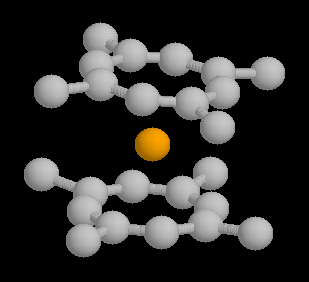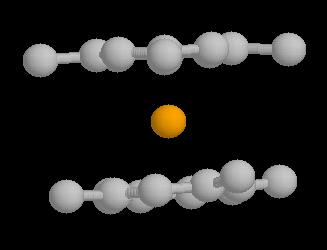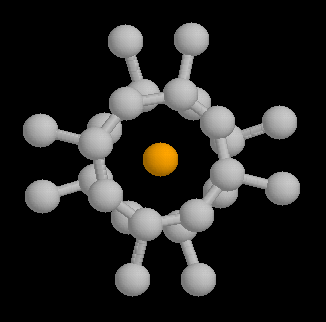 |
Electronic Conference on | |
|---|---|---|
| Organometallic Chemistry. | ||
| 30 June - 31 July 1997 |
 |
Electronic Conference on | |
|---|---|---|
| Organometallic Chemistry. | ||
| 30 June - 31 July 1997 |
The majority of web pages written by chemists also are restricted to this simple HTML approach. Web pages written like this offer little difference from documents printed on paper, with the notable exception of the hyperlink. These standard web pages offer static images of molecules and spectra.
But the web can offer much more. Web servers can deliver all types of files, not
just HTML, text, and gif or jpeg. Instead of viewing a static image
of a molecule, showing a single view from one direction, wouldn't the ability to
visualize a three-dimensional structure, rotate it, zoom in a particular region, be a
significant enhancement of the chemical content provided in the page? Instead of reporting
an NMR spectra by simply listing the chemical shifts and the multiplicity, why not deliver
the entire spectra which the reader can manipulate by enlarging a particular region,
rescaling, etc.? Instead of providing one or two snaphots of a trajectory, wouldn't an
animation of the entire process be much more valuable? These are some examples of an
enhanced web page. This technology is available today and can be easily incorporated
into any and all web pages for chemists.
MIME
All files delivered by a web server have a special tag attached that indicates the type of
file that is being delivered. This label is called a MIME (Multipurpose Internet Mail
Exchange) type. The MIME type is composed of two parts, the first is a generic label
indicating the file type, and the second part specifies the specific file format. For
example, an HTML file has the MIME type text/html where the first part
(text) indicates the file contains text, and the second part (html)
indicates that the format is HTML. Below is a list of some other MIME types. The middle
column gives the MIME type and the last column gives the usual file name extension.
| File type | MIME type | File name extension |
| HTML | text/html | .html, .htm |
| text | text/plain | .txt |
| gif image | image/gif | .gif |
| jpeg image | image/jpeg | .jpeg, .jpg |
| mpeg movie | video/mpeg | .mpeg, .mpg |
| Quicktime movie | video/quicktime | .qt, .mov, .snm |
| VRML | x-world/x-vrml ormodel/vrml | .wrl |
| portable data format (pdf) | application/pdf | |
| JavaScript file | application/x-javascript | .js |
| Mac Binhex file | application/mac-binhex40 | .hqx |
| Rich Text Format (RTF) file | application/rtf | .rtf |
When a file is sent by a server, the server attaches the appropriate MIME type to it. When the browser receives the file, it first examines the MIME type and decides what to do with the file. If the MIME indicates a file that the browser can handle by itself, such as an HTML file or a gif image, the browser will then process the file and deliver the contents to the screen. If it can't handle the file, the browser will examine its configuration file to see if an appropriate "helper application" is available. If there is a helper application available, the browser launches the application and directs the file as input into this new application. The file is then rendered to the screen in a separate window created and managed by the helper application. For example, if an MS-Word file is delivered, the browser will launch a local copy of MS-Word and the file will come up within the Word window ready for editing. If there is no helper available, the browser will offer to save the file to the local disk.
Incorporation of molecular coordinates into documents that a reader can then manipulate has been termed a hyperactive
molecule. The advantages of this approach are clear. Below is a 2-D representation
and a static picture of the crystal structure of octamethyluranocene. The hydrogen atoms have been removed for clarity.
If this is the only image provided, the reader will be left with a number of unaswered questions, such as
are the rings parallel to each other, are they eclipsed or staggered, do the methyl groups lie in the
plane of the cyclooctatetryl rings or do they bend upwards or downwards? The author might provide a couple of more
images to help answer these questions:
The above images have been provided simply as images using the HTML tag:
How can we turn this static representaion into an interactive tool? Instead of simply
providing the picture, we must provide the coordinates of the molecule. Coordinates can be
saved in a variety of file formats; each author should provide coordinates in a convenient form, but also one that
has an established MIME type, such as any of the formats listed in the
table above. In this example, the uranocene
molecule has been saved in the xyz format. The web server has been properly configure to attach the
chemical/x-xyz MIME type to the file.
A standard way to provide coordinates within a chemical document is to place a static image
within the page, chosing the most appropriate orientation. Then make this image a hyperlink
to the coordinate file. When a reader clicks on the image, the coordinate file is tramitted to
the browser, and the browser will launch the appropriate molecular visualization program. The
image below is actually a hyperlink to the molecular coordinates, and selecting it will start
this whole process.
The HTML code used to create this image and link is:
In the next section, we discuss how to embed hyperactive molecules within a web page, thereby avoiding
the use of an external helper application, using the plug-in module Chime.
Chemical MIME Types - the Key to Enhanced Web Pages
So how does all of this apply to chemistry? In 1994, Rzepa, Murray-Rust and
Whitaker developed the
idea of the chemical MIME type. These MIME types will specifiy the file formats
of typical applications used by chemists. For example, the 3-dimensional molecular
structure can be stored in a variety of formats, such as a GAUSSIAN input fie, an
MDL MOL file, a simple xyz file, etc. X-ray crystal structures are stored in the Protein
Data Bank (pdb) format or the Crystallographic Information File (cif) format. By
defining a MIME type for each of these, the browser can direct the file into an
appropriate program for visualizing the structure. Instead of just printing the file
to the screen, the browser can launch a molecular viewer, direct the coordinate file
in as input, and thereby allow the user to manipulate the structure, i.e. rotate it,
change the colors, zoom in, etc. MIME types have been established for spectra as well,
so that a full spectra can be loaded into a spectral viewer for manipulation by the
reader. A list of some of the Chemical MIME types is given below.
Chemical MIME Types
File Types MIME type File extension Brookhaven Protein Databank chemical/x-pdb .pdb Chem3D chemical/x-chem3d .c3d ChemDraw chemical/x-chemdraw .chm Crystalographic Information File chemical/x-cif .cif Daylight Smiles chemical/x-daylight-smiles .smi Gaussian Input File chemical/x-gaussian-input .gau IEMBL Nucleotide Format chemical/x-embl-dl-nucleotide .emb,.embl JCAMP-DX chmical/x-jcamp-dx .jdx Kinemage File chemical/x-kinemage kin MacMolecule chemical/x-macmolecule .mcm Macromodel Input File chemical/x-macromodel-input .mmd, .mmod MDL Molfile chemical/x-mdl-molfile .mol MDL RxnFile chemical/x-mdl-rxnfile .rxn MDL Transportable Graphics Format (tgf) chemical/x-mdl-tgf .tgf Mopac Input File chemical/x-mopac-input .mop Rosdal chemical/x-rosdal .ros XMol XYZ chemical/x-xyz .xyz
Product Platforms URL File Formats Accord Internet Chemistry Viewer Mac and PowerMac,
Windows 3.1, 95 and NThttp://www.synopsys.co.uk/accordiv.html
Accord's native format, MDL MOL, MDL Rxnfile, MDL Sketchfile,
Daylight SMILES, and SMD CS ChemOffice Net Mac
Windows
http://www.camsci.com/download.html
CS ChemDraw, CS Chem3D, MDL MOL, Brookhaven PDB JCAMPDX.EXE Windows 95 and NT
http://wwwchem.uwimona.edu.jm:1104/software/jcampdx.html JCAMP Mage Mac,
Windows 3.1,
SGI, SUN
http://www.prosci.uci.edu/kinemages/MageSoftware.html kinemage MDL Chime Mac and PowerMac,
Windows 3.1, 95 and NT, SGI
http://www.mdli.com/chemscape/chime/chime.html
MDL MOL, Brookhaven PDB, IEMBL Nucleotide Format, XMol XYZ,
Gaussian Input, Rasmol Script, Mopac Input, Chemical Structure
Markup Language, MDL Transportable Graphics, MDL RxnFile MDL ISIS/Draw Mac and PowerMac,
Windows 3.1, 95 and NThttp://www.mdli.com/prod/ioffer.html
MDL MOL, MDL TGF, MDL RXN MSI WebLab Viewer PowerMac,
Windows 95 and NT
Version 1.1 for Mac and Windows 3.1
http://www.msi.com/weblab/viewer/index.htm Brookhaven PDB,
MDL MOL, Insight II CAR and MDF, Cambridge CSD, Quanta MSF, Sybyl MOL2, Cerius2
MSI, Catalyst CPD, XMol XYZ, ISIS/Draw Sketch RasMol Mac and PowerMac,
Windows 3.1 and NT,
UNIX X11,
VAX/VMS
http://www.glaxowellcome.co.uk/netscape/software/
XMol XYZ, Brookhaven PDB, MDL MOL, Alchemy, Charmm XMol UNIX X11
http://www.msc.edu/msc/docs/xmol/XMol.html Alchemy, Chemlab, Gaussian Input, Gaussian
Output, Molsim, Mopac (Archive, Cartesian Input, Internal Input), Mopac Output,
PDB, and XMol XYZ Creating Chemical Enhanced Pages
In this section we will detail how to author a web page that includes
enhancements that make use of the chemical
MIME type. The specific example will detail how to incorporate a 3-dimension structure
of a molecule into a document so that the reader can manipulate the structure in her
own visualizer of choice. The following section will discuss the use of the Chime plug-in module and how to
employ it in creating enhanced documents.




The above image is a link to the coordinates
© Steven M. Bachrach and
Internet Journal of Chemistry